

Compact Muon Solenoid
LHC, CERN
| CMS-PAS-EXO-16-029 | ||
| Search for low-mass pair-produced dijet resonances using jet substructure techniques in proton-proton collisions at $\sqrt{s}= $ 13 TeV | ||
| CMS Collaboration | ||
| November 2016 | ||
| Abstract: Results from a search for paired boosted diquark resonances, using jet substructure techniques, are reported. This search uses data corresponding to an integrated luminosity of 2.7 fb$^{-1}$ from proton-proton collisions at a center-of-mass energy of $\sqrt{s}= $ 13 TeV, recorded by the CMS detector at the LHC in 2015. Limits at 95% confidence level are set on the production of top squarks decaying to two light quarks in the framework of R-parity violating supersymmetry. Top squarks with masses between 80 and 240 GeV are excluded. | ||
| Links: CDS record (PDF) ; inSPIRE record ; CADI line (restricted) ; | ||
| Figures & Tables | Summary | Additional Figures | References | CMS Publications |
|---|
| Figures | |
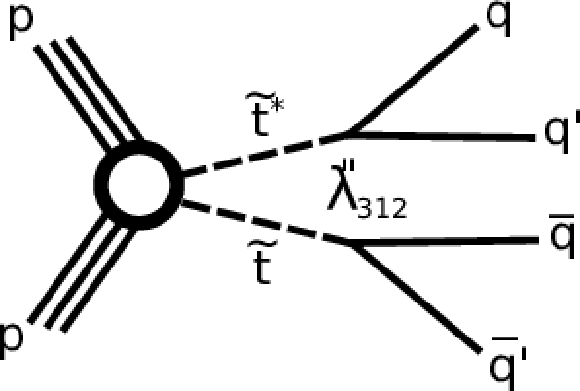
png pdf |
Figure 1:
Direct pair production of stops decaying via the hadronic RPV coupling $\lambda _{312}''$ into two light quarks. |
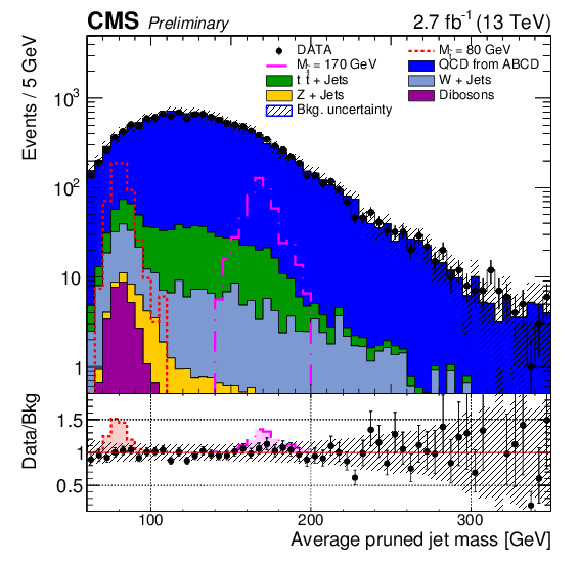
png pdf |
Figure 2:
Average pruned jet mass distribution shown for data (dots) and the total background prediction. The different background components are shown with different colors while the grey hashed band shows the total background uncertainty. On the bottom, ratio between data and background prediction, with the grey hashed band showing the total background uncertainty. The background uncertainties are described in Section 7 and summarized in Table 4. The shaded colored regions on the bottom indicate the expected top squark signal distributions shown for two different selected masses as they would appear in data. |
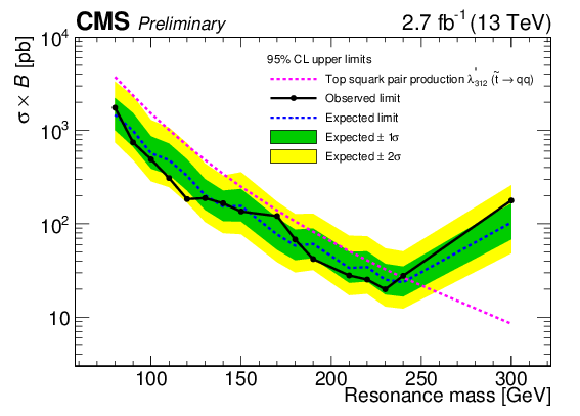
png pdf |
Figure 3:
Observed and expected 95% CL upper limits on cross section vs. stop mass. The dashed pink line shows the NLO + NLL theoretical predictions for stop pair production. |
| Tables | |
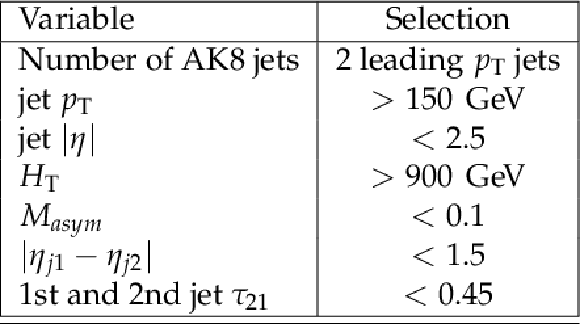
png pdf |
Table 1:
Summary of variables used in the analysis and the corresponding optimized selection. |

png pdf |
Table 2:
Definition of the regions A, B, C, D for the ABCD method. |
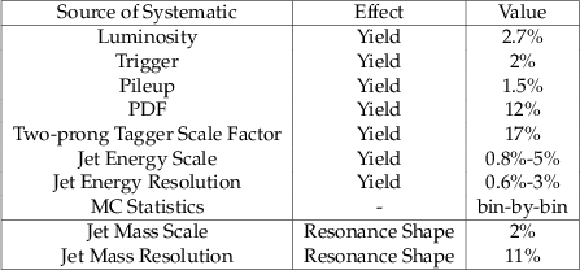
png pdf |
Table 3:
Overview of the systematic uncertainties on the signal acceptance by source. |

png pdf |
Table 4:
Overview of the systematic uncertainties on the background prediction by source. |
| Summary |
| A search has been performed for pair production of boosted resonances decaying to quarks giving a dijet signature from proton-proton collisions from the LHC at $\sqrt{s}=$ 13 TeV with the CMS detector. The distribution in the average pruned jet mass of selected events has been used to search for an excess compatible with a resonance signal above the SM background estimate. No significant deviation is found. Exclusion limits are set on the top squark pair production cross section with decays through the RPV SUSY coupling $\lambda^{''}_{\mathrm{312}}$ to light-flavor jets at 95% confidence level. We exclude stop masses between 80 GeV and 240 GeV. |
| Additional Figures | |
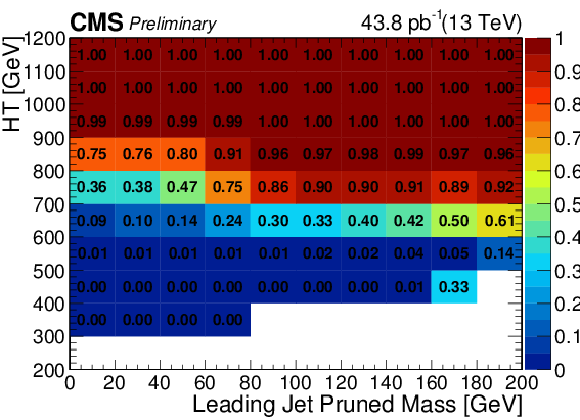
png pdf |
Additional Figure 1:
Trigger efficiency as a function of the total transverse hadronic energy ${H_{\mathrm {T}}}$ and the pruned jet mass measured in data. |

png pdf |
Additional Figure 2:
MC distributions of kinematic variables used in the analysis shown for backgrounds and signal. Each variable is plotted with all selection criteria apart from that on the variable being shown. The distributions are normalized to unit area. (Top left) $\tau _{21}$ distribution for the leading ${p_{\mathrm {T}}}$ jet, (top right) $\tau _{21}$ distribution for the second leading ${p_{\mathrm {T}}}$ jet, (bottom left) mass asymmetry $M_{asym}$, (bottom right) $| \eta _{j1} - \eta _{j2} |$. |
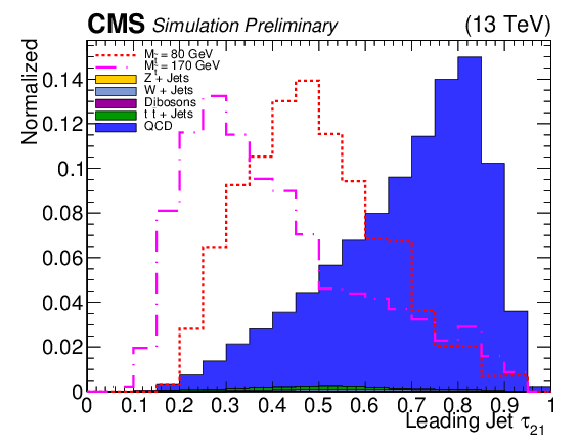
png pdf |
Additional Figure 2-a:
MC $\tau _{21}$ distribution for the leading ${p_{\mathrm {T}}}$ jet, shown for backgrounds and signal. The variable is plotted with all selection criteria apart from that on the variable being shown. The distribution is normalized to unit area. |
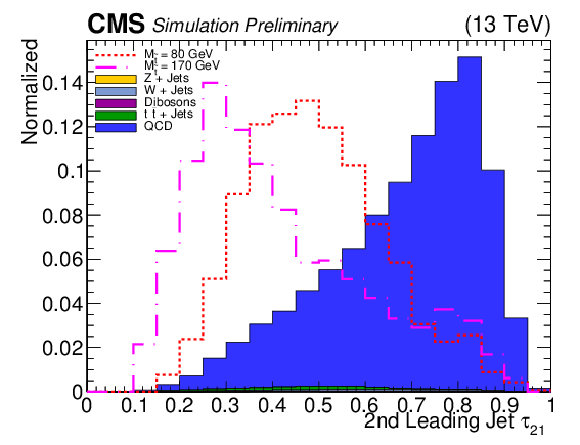
png pdf |
Additional Figure 2-b:
MC $\tau _{21}$ distribution for the second leading ${p_{\mathrm {T}}}$ jet, shown for backgrounds and signal. The variable is plotted with all selection criteria apart from that on the variable being shown. The distribution is normalized to unit area. |

png pdf |
Additional Figure 2-c:
MC mass asymmetry $M_{asym}$ distribution, shown for backgrounds and signal. The variable is plotted with all selection criteria apart from that on the variable being shown. The distribution is normalized to unit area. |
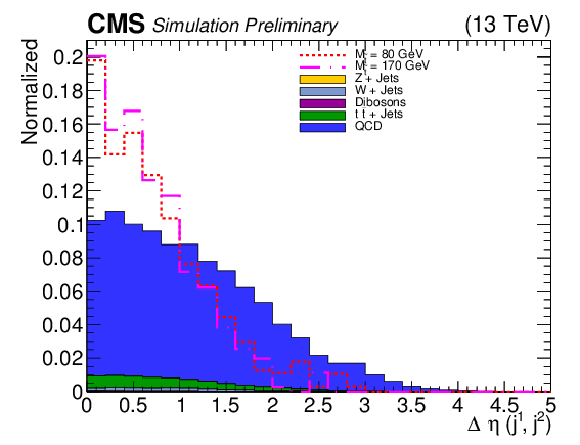
png pdf |
Additional Figure 2-d:
MC $| \eta _{j1} - \eta _{j2} |$ distribution, shown for backgrounds and signal. The variable is plotted with all selection criteria apart from that on the variable being shown. The distribution is normalized to unit area. |
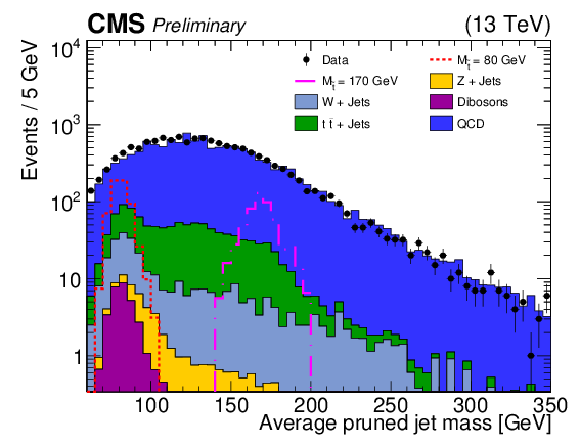
png pdf |
Additional Figure 3:
Data/MC comparison of the average pruned jet mass distribution after the final selection is applied. Data is shown in dots while the different background MC components are stacked with different colors. The expected signal distributions at different stop masses are also shown (dashed lines). The QCD multijets background is ultimately not estimated from MC in this analysis, but using data as described in the text. |

png pdf |
Additional Figure 4:
Transfer factor ratio (B/D) vs. averaged pruned jet mass, used in QCD multijets background estimate (ABCD), shown for data not corrected for resonant backgrounds (blue dots), data minus resonant background expectations from MC (red dots) and the sum of all the MC backgrounds (green crosses). Fits to the data (blue line), data minus resonant backgrounds (red line) and to the MC (blue solid line) with the sigmoid function: $ (p_0 + \exp( p_1 + p_2 x^3 ))^{-1} $ from 60 GeV to 350 GeV are also shown. Thin red dashed lines show the uncertainties from the fit to the data minus the resonant backgrounds. |
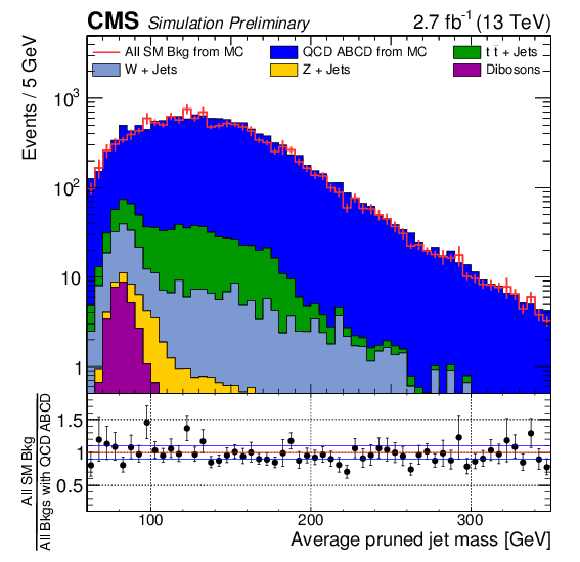
png pdf |
Additional Figure 5:
Average pruned jet mass distribution demonstrating the closure of the ABCD QCD multijets background estimation. Red line: the sum of all SM MC backgrounds after applying the final analysis selection. On the bottom, the ratio between the two background predictions is shown, and the blue lines represents the level of closure found to be $\pm$10 % which is used as a systematic uncertainty on the yield of the ABCD background prediction. |
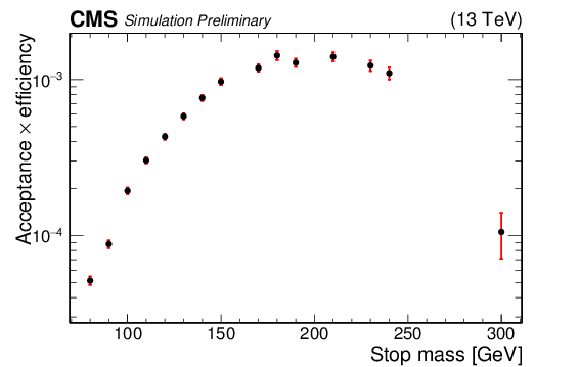
png pdf |
Additional Figure 6:
Acceptance times efficiency vs. stop mass from the Monte Carlo simulation. |
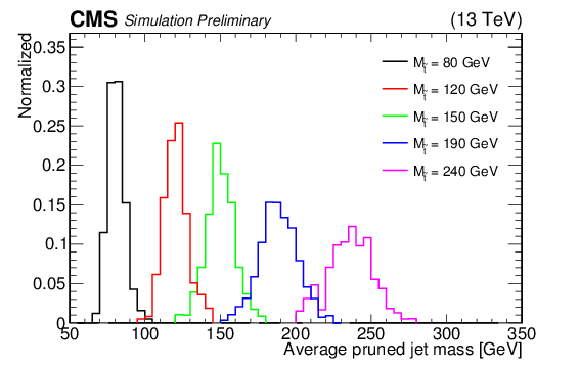
png pdf |
Additional Figure 7:
Signal mass distributions for various simulated stop masses probed in this analysis after applying the final analysis selection. These distributions are scaled to unit area. |
| References | ||||
| 1 | H. P. Nilles | Supersymmetry, supergravity and particle physics | Phys. Rep. 110 (1984) 1 | |
| 2 | H. E. Haber and G. L. Kane | The search for supersymmetry: Probing physics beyond the standard model | Phys. Rep. 117 (1985) 75 | |
| 3 | M. Papucci, J. Ruderman, and A. Weiler | Natural SUSY endures | JHEP 09 (2012) 035 | |
| 4 | R. Barbieri and G. F. Giudice | Upper bounds on supersymmetric particle masses | Nucl. Phys. B 306 (1988) 63 | |
| 5 | S. Dimopoulos and G. F. Giudice | Naturalness constraints in supersymmetric theories with nonuniversal soft terms | PLB 57 (1995) 573 | hep-ph/9507282 |
| 6 | R. Barbieri and D. Pappadopulo | S-particles at their naturalness limits | JHEP 10 (2009) 61 | 0906.4546 |
| 7 | A. G. Cohen, D. B. Kaplan, and A. E. Nelson | The more minimal supersymmetric standard model | PLB 388 (1996) 588 | hep-ph/9607394 |
| 8 | R. Barbier et al. | R-Parity-violating supersymmetry | Phys. Rep. 420 (2005) 1 | |
| 9 | J. A. Evans and Y. Kats | LHC Coverage of RPV MSSM with Light Stops | JHEP 1304 (2013) 28 | 1209.0764 |
| 10 | CDF Collaboration | Search for Pair Production of Strongly Interacting Particles Decaying to Pairs of Jets in $ p \bar{p} $ Collisions at $ \sqrt{s} = $ 1.96 TeV | PRL 111 (2013) 3 | 1303.2699 |
| 11 | CMS Collaboration | Search for pair-produced resonances decaying to jet pairs in proton–proton collisions at $ \sqrt{s} =$ 8 TeV | PLB 747 (2015) 98 | CMS-EXO-12-052 1412.7706 |
| 12 | ATLAS Collaboration | A search for pair produced resonances in four jets final states in proton-proton collisions at $ \sqrt{s} =$13 TeV with the ATLAS experiment | ATLAS-CONF-2016-084 | |
| 13 | ATLAS Collaboration | A search for $ \mathbf{R} $-parity violating scalar top decays in all-hadronic final states with the ATLAS detector in $ \sqrt{s}=$ 8TeV $ \mathbf{pp} $ collisions | ATLAS-CONF-2015-026 | |
| 14 | ATLAS Collaboration | A search for R-parity violating decays of the top squark in four jet final states with the ATLAS detector at $ \sqrt{s}=$ 13 TeV | ATLAS-CONF-2016-022 | |
| 15 | CMS Collaboration | CMS Luminosity Measurement for the 2015 Data Taking Period | CMS-PAS-LUM-15-001 | CMS-PAS-LUM-15-001 |
| 16 | CMS Collaboration | The CMS experiment at the CERN LHC | JINST 3 (2008) S08004 | CMS-00-001 |
| 17 | M. Dasgupta, A. Fregoso, S. Marzani, and G. P. Salam | Towards an understanding of jet substructure | JHEP 09 (2013) 029 | 1307.0007 |
| 18 | D. Adams et al. | Towards an Understanding of the Correlations in Jet Substructure | EPJC 75 (2015) 9 | 1504.00679 |
| 19 | CMS Collaboration | Pileup Removal Algorithms | CMS-PAS-JME-14-001 | CMS-PAS-JME-14-001 |
| 20 | J. Alwall et al. | The automated computation of tree-level and next-to-leading order differential cross sections, and their matching to parton shower simulations | JHEP 07 (2014) 079 | 1405.0301 |
| 21 | T. Sjostrand, S. Mrenna, and P. Z. Skands | A Brief Introduction to PYTHIA 8.1 | CPC 178 (2008) 852 | 0710.3820 |
| 22 | E. Farhi and L. Susskind | Grand Unified Theory with Heavy Color | PRD 20 (1979) 3404 | |
| 23 | W. J. Marciano | Exotic New Quarks and Dynamical Symmetry Breaking | PRD 21 (1980) 2425 | |
| 24 | P. H. Frampton and S. L. Glashow | Unifiable Chiral Color with Natural Glashow-Iliopoulos-Maiani Mechanism | PRL 58 (1987) 2168 | |
| 25 | P. H. Frampton and S. L. Glashow | Chiral Color: An Alternative to the Standard Model | PLB 190 (1987) 157 | |
| 26 | R. S. Chivukula, M. Golden, and E. H. Simmons | Multi-jet Physics at Hadron Colliders | Nucl. Phys. B 363 (1991) 83 | |
| 27 | C. Borschensky et al. | Squark and gluino production cross sections in pp collisions at $ \sqrt{s} $ = 13, 14, 33 and 100 TeV | EPJC74 (2014) 12 | 1407.5066 |
| 28 | W. Beenakker, R. Hopker, M. Spira, and P. M. Zerwas | Squark and gluino production at hadron colliders | Nucl. Phys. B 492 (1997) 51 | hep-ph/9610490 |
| 29 | A. Kulesza and L. Motyka | Threshold Resummation for Squark-Antisquark and Gluino-Pair Production at the LHC | PRL 102 (2009) 111802 | 0807.2405 |
| 30 | A. Kulesza and L. Motyka | Soft gluon resummation for the production of gluino-gluino and squark-antisquark pairs at the LHC | PRD 80 (2009) 095004 | 0905.4749 |
| 31 | W. Beenakker et al. | Soft-gluon resummation for squark and gluino hadroproduction | JHEP 12 (2009) 041 | 0909.4418 |
| 32 | W. Beenakker et al. | Squark and gluino hadroproduction | Int. J. Mod. Phys. A 26 (2011) 2637 | 1105.1110 |
| 33 | W. Beenakker et al. | NLO+NLL squark and gluino production cross-sections with threshold-improved parton distributions | EPJC 76 (2016) 2 | 1510.00375 |
| 34 | P. Skands, S. Carrazza, and J. Rojo | Tuning PYTHIA 8.1: the Monash 2013 Tune | EPJC 74 (2014) 3024 | |
| 35 | P. Nason | A New Method for Combining NLO QCD with Shower Monte Carlo Algorithms | JHEP 11 (2004) 040 | |
| 36 | S. Frixione, P. Nason, and C. Oleari | Matching NLO QCD computations with Parton Shower simulations: the POWHEG method | JHEP 11 (2007) 070 | |
| 37 | S. Alioli, P. Nason, C. Oleari, and E. Re | A general framework for implementing NLO calculations in shower Monte Carlo programs: the POWHEG BOX | arXiv:1002.2581 | 1002.2581 |
| 38 | GEANT4 Collaboration | Geant4---a simulation toolkit | NIMA 506 (2003) 250 | |
| 39 | CMS Collaboration | Commissioning of the Particle-flow Event Reconstruction with the first LHC collisions recorded in the CMS detector | CDS | |
| 40 | M. Cacciari, G. P. Salam, and G. Soyez | The Anti-$ k_t $ Jet Clustering Algorithm | JHEP 04 (2008) 63 | 0802.1189 |
| 41 | M. Cacciari, G. P. Salam, and G. Soyez | FastJet User Manual | EPJC 72 (2012) 1896 | 1111.6097 |
| 42 | D. Krohn, J. Thaler, and L.-T. Wang | Jet Trimming | JHEP 02 (2010) 084 | 0912.1342 |
| 43 | CMS Collaboration | Determination of jet energy calibration and transverse momentum resolution in CMS | JINST 6 (2011) 11002 | CMS-JME-10-011 1107.4277 |
| 44 | CMS Collaboration | Jet Performance in pp Collisions at 7~TeV | CDS | |
| 45 | S. D. Ellis, C. K. Vermilion, and J. R. Walsh | Recombination Algorithms and Jet Substructure: Pruning as a Tool for Heavy Particle Searches | PRD81 (2010) 094023 | 0912.0033 |
| 46 | J. Thaler and K. Van Tilburg | Maximizing Boosted Top Identification by Minimizing N-subjettiness | JHEP 02 (2012) 093 | 1108.2701 |
| 47 | CMS Collaboration | Identification of b quark jets at the CMS Experiment in the LHC Run 2 | CMS-PAS-BTV-15-001 | CMS-PAS-BTV-15-001 |
| 48 | CMS Collaboration | Search for massive resonances decaying into pairs of boosted W and Z bosons at $ \sqrt{s} $ = 13 TeV | CMS-PAS-EXO-15-002 | CMS-PAS-EXO-15-002 |
| 49 | NNPDF Collaboration | Parton distributions for the LHC Run II | JHEP 04 (2015) 040 | 1410.8849 |
| 50 | A. L. Read | Presentation of search results: the CL s technique | Journal of Physics G 28 (2002) 10 | |
| 51 | T. Junk | Confidence level computation for combining searches with small statistics | NIMA 434 (1999) 2 435 | |

|
Compact Muon Solenoid LHC, CERN |

|

|

|

|

|

|